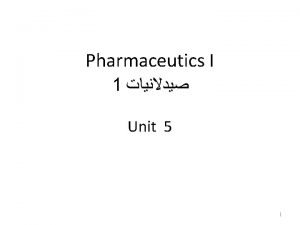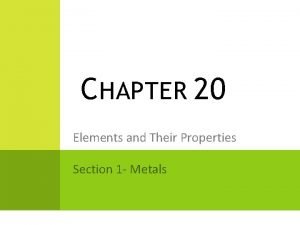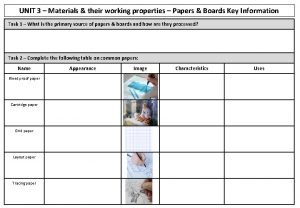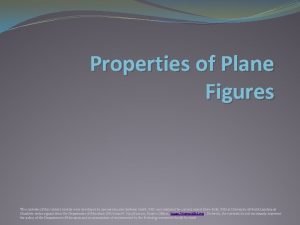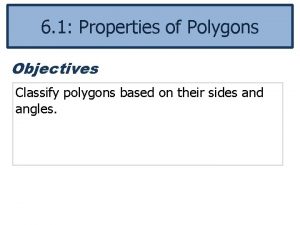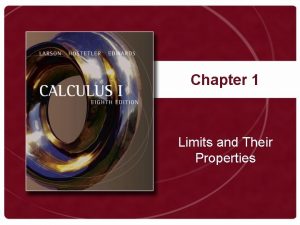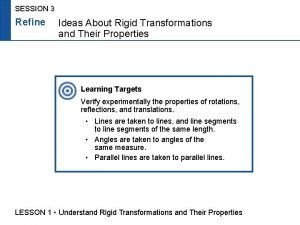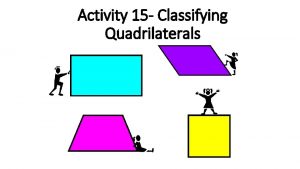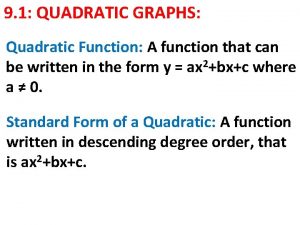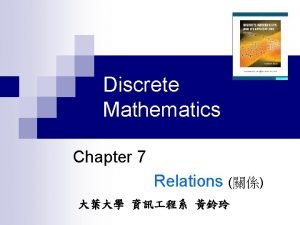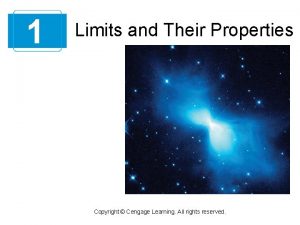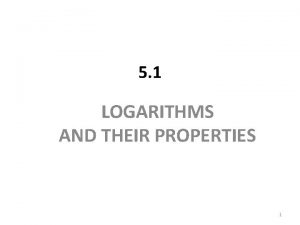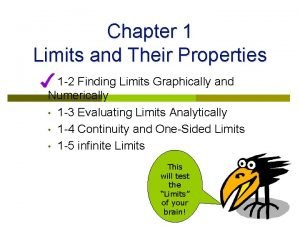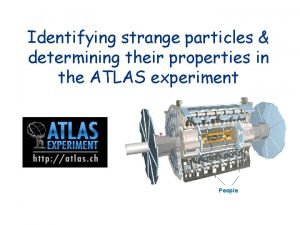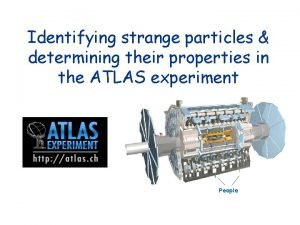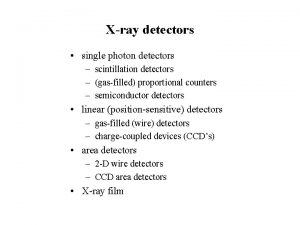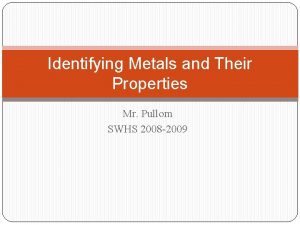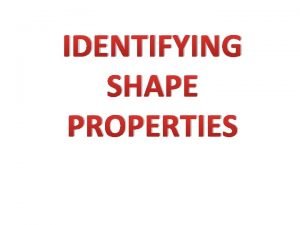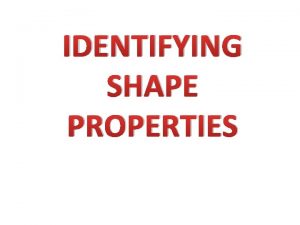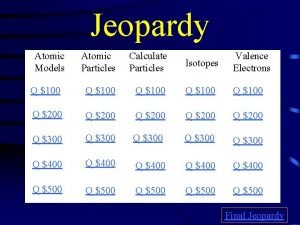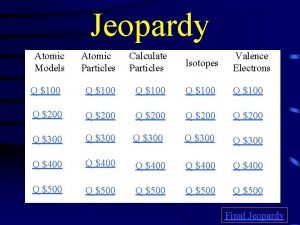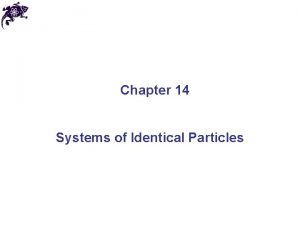Identifying particles their properties in detectors An inquiry











































- Slides: 43

Identifying particles & their properties in detectors An inquiry based learning scenario – for able A Level students who have recently studied the particle physics content -an extension & enhancement or use as a practice for synoptic questions at the end of the course Time estimate/suggestion: ½ hr intro in one lesson + homework + 1 ½ hrs next lesson

Phase 1: Question Eliciting Activities A brief introduction to be done in class • Stimulate curiosity • Define questions from current knowledge

What particles have we been learning about? and

Hadrons • Baryons - made up of 3 quarks eg protons & neutrons • Mesons - made up of 2 quarks eg pions & kaons

Leptons ……Which also have their antiparticles but no sub structure

Force carriers – Bosons • We have a theory that the forces that particles experience arise from exchange of particles called bosons - g photons for em forces - g gluons for the strong force between quarks - W & Z for the weak force which explains things like b decay & nuclear reactions in stars…

And we know… • • Energies Masses Charges Momentum & conservation rules (charge, baryon number, lepton number, strangeness…) for particle interactions….

What evidence do we have for this? • Physicists have designed and carried out experiments • Collected analysed data • Using particle detectors

A brief history…… • As an a particle passes through a cloud chamber, it collides with the gas particles inside, ionising atoms. • The supercooled, supersaturated alcohol vapour condenses around the ions formed leaving a vapour trail to show up the particle path.

Spark chambers were widely used in the 1970 s… • Spark-chamber detectors consist of metal plates placed in a sealed box filled with a gas such as helium, neon or a mixture of the two. As a charged particle travels through the detector, it will ionise atoms of the gas between the plates. At the same time, detectors above and below the chamber activate a high voltage to the plates to create an electric field, producing sparks on the particle’s exact trajectory.

Bubble chambers were more useful research tools…. . • The bubble chamber, invented by Donald Glaser in 1952, consists of a tank of unstable (superheated) liquid – for example, hydrogen or a mixture of neon and hydrogen at a temperature of about 30 K. This liquid is very sensitive to the passage of charged particles, which initiate boiling as a result of the energy they deposit by ionising the atoms as they force their way through the liquid.

• The liquid is prepared and held under a pressure of about 5 atmospheres (1 atm=105 Pa). • Just before the beam arrives from the accelerator, the pressure is reduced to about 2 atmospheres making the liquid superheated. • As charged beam particles pass through the liquid they deposit energy by ionising atoms and this causes the liquid to boil along their paths.

• Some beam particles may also collide with an atomic nucleus ( a proton in a hydrogen atom) – this is what we want to study - and the charged particle products of such interactions also ionise the liquid causing trails of bubbles to form. • The bubbles formed are allowed to grow for a few ms, and when they have reached a diameter of about 1 mm, a flash photograph is taken (on several views so as to enable the interactions to be reconstructed in 3 -dimensions). • The pressure is then increased again to clear the bubbles and await the arrival of the next burst of beam particles.

Modern detectors are more complex and rely on electronics & computer technology…. • But work with similar underlying principles

What are the principles used? • Ionisation of a medium to show the paths of charged particles • Magnetic fields to exert forces on charged particles and so bend their paths – to identify charge and enable momentum to be calculated • Absorbing materials to stop particles and so enable energy to be calculated

Phase 2. 1: Define questions from current knowledge • Which particles can we detect – are there any we can’t ? • How do we find their - trajectory - charge - momentum - energy ? • What characteristics do we look for in the particle tracks to identify which particle it is?

Phase 2. 2: Plan & conduct simple investigations A homework suggestion GOALS: • To learn more about detectors and the characteristics of particle paths in them • To make some observations and measurements

PREPARATION Explore the physics of bubble chambers at: http: //teachers. web. cern. ch/teachers/archiv/HST 2005/bu bble_chambers/BCwebsite/index. htm & Explore the physics of the ATLAS detector at: http: //atlas. ch/ - Click on “multimedia” and then “how atlas works” and “animated clips” - Click on “e-tours” and look at these too.

• Start the Minerva software from the portal toolbox – click on “toolbox” at the top of the page, scroll down to Minerva 2 D analysis tool, and click the “start Minerva” red box. • Read through the introduction, using the forward and backward arrows, and work through the 5 tutorial examples. • Check your score…and try more examples if you have time!

Phase 2. 3: Propose preliminary explanations Teacher coordinated activity in following lesson STUDENTS FEED BACK SOME POSSIBLE EXPLANATIONS TO THE QUESTIONS POSED PREVIOUSLY:

Which particles can we detect – are there any we can’t ? • Most particles can be detected by various sections of a modern detector • Neutrinos have no charge and very little mass and rarely interact with matter – we detect their presence only by noting “missing” energy & momentum in collisions Typical detector parts

What characteristics do we look for in the particle tracks to identify which particle it is? • Small charged particles, like electrons & positrons, leave tracks in the tracking chamber (where magnetic fields are also applied to enable momentum measurement) and deposit all of their energy in the em calorimeter, where it can be measured. • Neutral particles, like a photon, can deposit energy in the em calorimeter, but leave no track in the tracking chamber

……………. • • • Charged particles, consisting of quarks, like protons, leave tracks in the tracking chamber (where a magnetic field is also applied to enable momentum measurement) and deposit their energy in the hadronic calorimeter, where it can be measured. Neutral particles, consisting of quarks, like neutrons, also deposit energy in the hadronic calorimeter, but leave no track in the tracking chamber Muons pass through all the detector layers, leaving tracks, and depositing small amounts of energy in all calorimeters. In the muon spectrometer, a large magnetic field is applied which enables momentum measurement.

Interactions of particles with the detectors Summary e+ n leaves no track at all

How do we find the particle - trajectory • By the ionisation it causes in the matter through which it passes. • Tracking devices reveal the paths of electrically charged particles through the trails they leave behind. There are similar every-day effects: high-flying airplanes seem invisible, but in certain conditions you can see the trails they make. In a similar way, when particles pass through suitable substances the interaction of the passing particle with the atoms of the substance itself can be revealed. • Most modern tracking devices do not make the tracks of particles directly visible. Instead, they produce tiny electrical signals that can be recorded as computer data. A computer program then reconstructs the patterns of tracks recorded by the detector, and displays them on a screen.

How do we find the particle - charge? • The charge on a particle can be determined by the curvature of its path in a magnetic field eg electron path in a bubble chamber (Electrons spiral because they are much lighter than all other charged particles and lose energy quickly by another process called bremsstrahlung ) A positron, with opposite charge, would spiral in the opposite direction

Motion of charged particle in magnetic fields • The direction of the force on the particle is determined by Fleming’s Left hand Rule: The current direction is the direction in which a POSITIVE charge is travelling. For a negative charge, this direction is reversed, which reverses the force direction

This force provides a centripetal force from which we can deduce particle momentum • F = Bqv • F = mv 2 / r ➱ mv 2 / r = Bqv and momentum P = mv = Bqr Hence a particle’s momentum can be calculated from the radius of curvature of its path – this happens in the tracking chambers of all detectors

How do we find the particle - energy? • A calorimeter measures the energy lost by a particle that goes through it. It is usually designed to entirely stop or ‘absorb’ all of the particles coming from a collision, forcing them to deposit all of their energy within the detector. • Calorimeters typically consist of layers of ‘passive’ or ‘absorbing’ high–density material (lead for instance) interleaved with layers of ‘active’ medium such as liquid argon. .

• Electromagnetic calorimeters measure the energy of light particles – electrons and photons – as they interact with the electrically charged particles inside matter. e- High energy e- e- g e+ The high energy e- interacts with the absorbing material, producing a shower of low energy e-, e+, g, until it stops. The shower of low energy particles passes into the active material, ionising atoms. The free e- so created are attracted towards copper electrodes, where the charge is measured. From this, the original energy of the high energy ecan be calculated • Hadronic calorimeters sample the energy of hadrons (particles containing quarks, such as protons and neutrons) as they interact with atomic nuclei High energy p p p The high energy p interacts with an atomic nucleus in the absorbing plates, leading to a shower of particles. These particles enter a scintillating material, causing it to radiate light. Long fibres carry the light to devices where the intensity is measured and converted to an electric current, from which the energy of the incoming proton is measured.

Phase 3. 2: Gather evidence from observation • Identifying Z decays to electron + positron or to muon + antimuon & estimating Z mass Z e- + e+ ee+ Z mm+ or Z m- + m+ Group follow on activity in class – teacher intro to background theory, followed by class activity

Working in groups • In the Minerva 2 D Analysis Tool page, click on the “masterclass resources” box, and scroll down to computer set up. Choose a suitable version (depending on class size) and download the sets of events – click save, then right click on saved file and extract all (from the zip file) • Start the Minerva software from the portal toolbox – click on “toolbox” at the top of the page, scroll down to Minerva 2 D analysis tool, and click the “start Minerva” red box. • To display the events of a given group, go to File (upper left corner of the right panel), then click on Read Events Locally, select the Minerva file from where you have saved it, select the events folder and then the group you want to display, and click Open. TEACHERS MAY WANT TO LIAISE WITH THE IT TECHNICIAN IN SCHOOL TO MAKE THIS EVENTS FOLDER ACCESSIBLE IN A SPECIFIED FILE ON THE SCHOOL NETWORK

……. • Print off the Atlantis Instructions, Summary sheet and Overview sheet in the paperwork section on this page. • Each group takes a sample of 20 events from the Minerva web site and identifies the events within this set that possibly show a Z boson decaying to either e- & e+ or m- & m+ • For each such event, calculate the invariant mass of the Z particle

What is invariant mass? ? • The invariant mass or rest mass, is a characteristic of the total energy and momentum of an object or a system of objects that is the same in all frames of reference • When the system as a whole is at rest, the invariant mass is equal to the total energy of the system divided by c 2, which is equal to the mass of the system as measured on a scale.

In general…. . using SI units… 2 E = 2 2 pc + 2 4 mc where m is the invariant mass or rest mass. If a Z boson decays into e- + e- , then energy and momentum must be conserved: ∑ Ee , Ee = E Z and ∑ pe , pe = p. Z remembering p is a vector quantity! Then m. Z can be calculated: m 2 = E 2 - p 2 c 2 c 4

Units Particle physicists work with less familiar units that simplify the equation: 2 E E is measured in Ge. V = 2 p + P is measured In Ge. V/c often just called Ge. V in the software 2 m m is measured in Gev/c 2 1 e. V = energy gained by e- when accelerated through a PD of 1 V = 1. 6 x 10 -19 J 1 Ge. V = 109 e. V

Using these units… 2 m m comes out in in Gev/c 2 = when 2 E - E is measured in Ge. V & 2 p p is measured in Ge. V/c

Process to calculate Z invariant mass: In this exercise we are going to make some approximations – our results won’t be exact but we will have learnt a process and how to think along the same lines as a particle physicist!!

2 E = 2 p + 2 m • For electrons and muons, m << p So we can approximate that E = p • Z particles have a big mass, so we can’t use this approximation for Z bosons!

Once you have identified a Z e- + e+ event… • Click on the hand symbol near the top of the GUI box of the software, then click on one of the electron/positron tracks • Note the momentum components along the 3 axes, px, py and pz • Assume Ee = p e by our approximation, = (px 2 + py 2 + pz 2)1/2

• Repeat the process for the other electron/positron track • Calculate the invariant mass of the original Z boson in each case: m. Z = [ (Ee + Ee)2 - (px e + px e)2 - (py e + py 2 ]1/2 ) e An excel spread sheet could be designed to do this Repeat this procedure for events showing Z decaying to muon + anti-muon.

Phase 4: Collating and discussing results • Groups come back together and tabulate values of mass calculated for the possible Z boson • A histogram of frequency against mass is plotted • Discussion of whether Z mass is positively identified and to what accuracy

Phase 5: Discussion of measurement technique • The Higgs boson and the concept of the Higgs field was postulated by Peter Higgs in the 1960 s to try to explain why particles have such diverse masses. • Its maximum mass and modes of decay have been mathematically predicted but it is the only particle in the current standard model that has never been observed experimentally • Physicists will use very similar techniques to the one used in this project to look for signature Higgs events and determine the Higgs mass • And if the Higgs is not found…. . a new theory has to emerge!
 Identifying and non identifying adjective clauses
Identifying and non identifying adjective clauses Identifying and non identifying adjective clauses
Identifying and non identifying adjective clauses Whats an adjective clause
Whats an adjective clause What is identifying the inquiry and stating the problem
What is identifying the inquiry and stating the problem Diagnosing error in object detectors
Diagnosing error in object detectors Photo detectors
Photo detectors Rhmd: evasion-resilient hardware malware detectors
Rhmd: evasion-resilient hardware malware detectors What is thermal detector
What is thermal detector Adsorption chromatography
Adsorption chromatography Nuclear detectors
Nuclear detectors Feature detectors
Feature detectors Streaming current detectors
Streaming current detectors Where are feature detectors located
Where are feature detectors located Giant wave detectors murmurs universe
Giant wave detectors murmurs universe Frontier detectors for frontier physics
Frontier detectors for frontier physics Vhv voltage detectors
Vhv voltage detectors Feature detectors ap psychology
Feature detectors ap psychology Wave could hear murmurs across universe
Wave could hear murmurs across universe Suspending agent example
Suspending agent example Dispersed system
Dispersed system Three subatomic particles and their charges
Three subatomic particles and their charges Properties used to identify substances
Properties used to identify substances Extensive and intensive examples
Extensive and intensive examples Physical and chemical properties
Physical and chemical properties Anthanides
Anthanides Cartridge paper properties
Cartridge paper properties Plane figures and their properties
Plane figures and their properties Inner transition metals
Inner transition metals Attributes of polygons
Attributes of polygons Practice a investigating graphs of polynomial functions
Practice a investigating graphs of polynomial functions Limits and their properties
Limits and their properties Ionic bond strength
Ionic bond strength Understanding rigid transformations and their properties
Understanding rigid transformations and their properties Additional practice 15-2 classify shapes
Additional practice 15-2 classify shapes Classification of waste according to their properties
Classification of waste according to their properties Investigating graphs of functions for their properties
Investigating graphs of functions for their properties Quadratic graphs and their properties
Quadratic graphs and their properties Chapter 1 limits and their properties
Chapter 1 limits and their properties Relations and their properties
Relations and their properties Elements and their properties section 1 metals
Elements and their properties section 1 metals Discrete presentation
Discrete presentation Limits and their properties
Limits and their properties Log properties
Log properties Limits and their properties chapter 1 answers
Limits and their properties chapter 1 answers


















